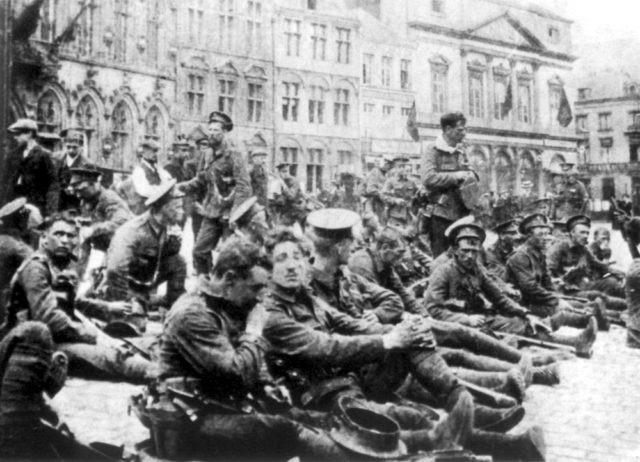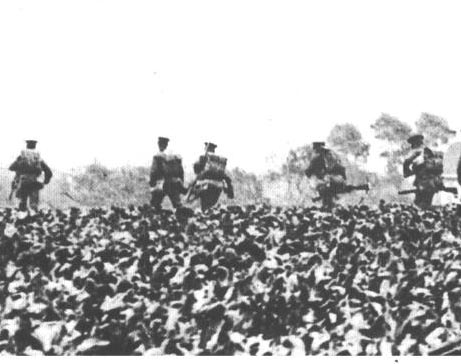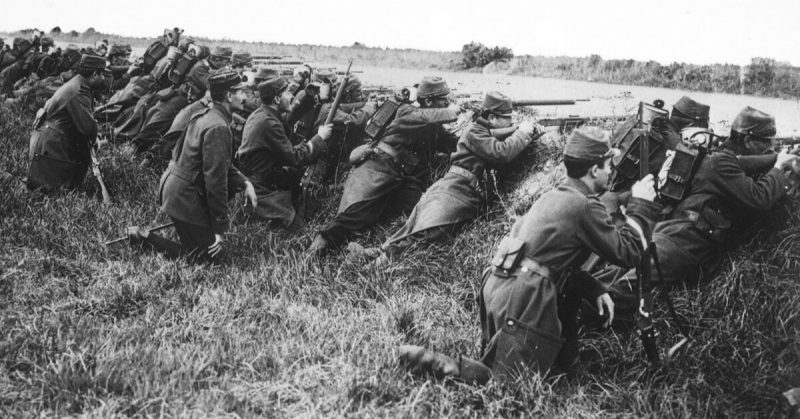At the start of the First World War, the commanders of both sides expected fast-moving action. They believed devastating modern weapons would open gaps in the enemy lines, allowing breakthroughs which could be exploited by cavalry or fast-marching infantry. In the first few months this occurred, leading to a series of engagements, unlike the trench warfare for which WWI became known.
One of these, which was given disproportionate significance by the British, was the Battle of Mons.
The Bridges at Mons
The Belgian town of Mons is at a junction of transport networks, including the Mons-Condé Canal. Four bridges crossed the canal at Nimy, just north of Mons, including a road bridge to Brussels and a railway bridge on the main line from Brussels to Paris.
The two sides of the war were caught up in what became known as the Race for the Sea. Each army was attempting to outflank the other. When these maneuvers were blocked, they moved further north, taking the war across the Low Countries to the coast.
The presence of important road and railway bridges made Mons a significant objective in this race. The British Expeditionary Force (BEF) arrived first. Setting up machine-gun posts and explosive charges on the bridges, they settled in to hold off any German advance.
First Contact
On the morning of Sunday, August 23, 1914, a German cavalry patrol rode out of the mist toward the canal at Nimy. The cavalry were an important military unit at the start of the war. They used their mobility to get ahead of the infantry and exploit breakthroughs in the enemy lines. The terrible efficiency with which they would be destroyed by machine guns had not yet been shown.

This cavalry unit was about to get a taste of what was to come. As they approached the bridge, the British 4th Royal Fusiliers, who had machine-gunners by the bridge and infantry along the road, opened fire. The cavalry retreated.
Then German artillery pounded the area. The 84th Infantry began an advance on the bridges. To the east, the 31st Infantry approached the railway station where the British troops of the 4th Middlesex were waiting.
Discipline vs. Discipline
The British troops were well-trained professionals, not the volunteer regiments who would do much of the fighting later in the war. Through experience and training, each soldier could fire fifteen rounds in a minute.
As a result of this and the emplaced machineguns, the Germans walked into a wall of bullets. They too were disciplined. Even as vast numbers of their comrades fell dead and wounded, they kept advancing.
The artillery of both sides joined the fight. Lines of sight were obscured by the buildings of Mons and the surrounding area. The British struggled to bring counter-battery fire against the Germans. As the Germans brought up more artillery, the battle lines spread.

C Company at Nimy
At Nimy, C Company of the Fusiliers came under immense pressure. The Germans, learning from their initial losses, abandoned massed advances attacking instead in small repeated rushes. Using these tactics, they were able to make use of cover on the canal-side embankments. The British were suffering under heavy fire.
The last of C Company’s machine-gunners, Lieutenant M. J. Dease, was wounded five times at his post and later died at a dressing station. Private Frank Godley took his place for nearly an hour. When the Germans broke through he threw the machine-gun into the river to prevent them capturing it. He was taken prisoner.
Pressure and Withdrawal
At the train station, the 4th Middlesex held until nearly noon. As they withdrew, one man stayed behind on the roof to provide covering fire. He died as the Germans stormed the station.
At Nimy, a German soldier named Niemeyer provided a way across the canal. Leaping in under fire, he triggered the mechanism of a drawbridge, letting his comrades cross. Further east, the Germans found an unguarded crossing.
At 1310, the British withdrew down the road toward Brussels.
To Every House a Gunner
On the west flank, the Germans found every building on the flat ground around St Ghislain seemed to hold a British rifleman. The 12th Brandenburg Grenadiers lost 500 casualties crossing this area.
For all the damage they were doing, the British could not hold. With the bridges lost at Nimy, the Germans were pouring across the canal. The men of the 1st Queen’s Own Royal West Kent, holding the houses near St Ghislain, were forced to withdraw rather than be outflanked.
Blowing the Bridges
The British tried to blow the bridges as they left, with mixed success. At Jemappes, two soldiers managed to destroy the bridges, despite coming under fire from the enemy. At Mariette, Captain Wright of the Royal Engineers swung hand over hand beneath the bridge to connect explosive charges but was still unable to destroy the bridge.
Exaggeration and Angels
By the end of the day, the British had abandoned Mons. They had inflicted 5,000 casualties on the Germans, in return for 1,600 men lost.
Their withdrawal could hardly be called a victory, but it had been successful enough to deserve some celebration. Several Victoria Crosses were awarded, including the machine-gunners Lieutenant Dease and Private Godley and the men who blew the bridges at Jemappes.
Given a success to celebrate, the story became exaggerated. A journalist named Arthur Machen added to the story when he said that angels had appeared over Mons in the form of bowmen from the British victory at Agincourt. Machen later admitted to making the story up.
The Battle of Mons was no victory for the British, but it helped them to believe they could win.
Source:
Martin Marix Evans (2002), Over the Top: Great Battles of the First World War.
